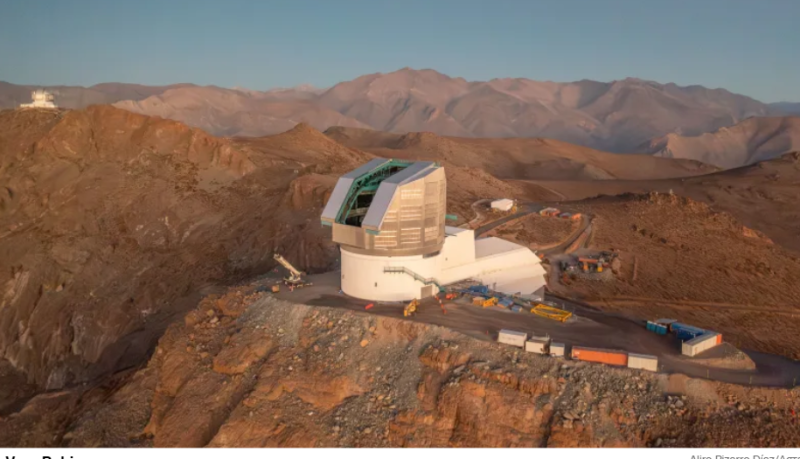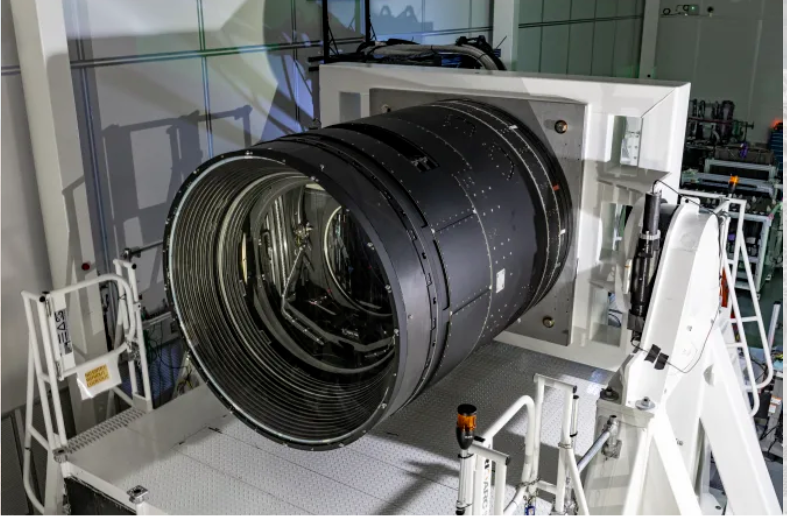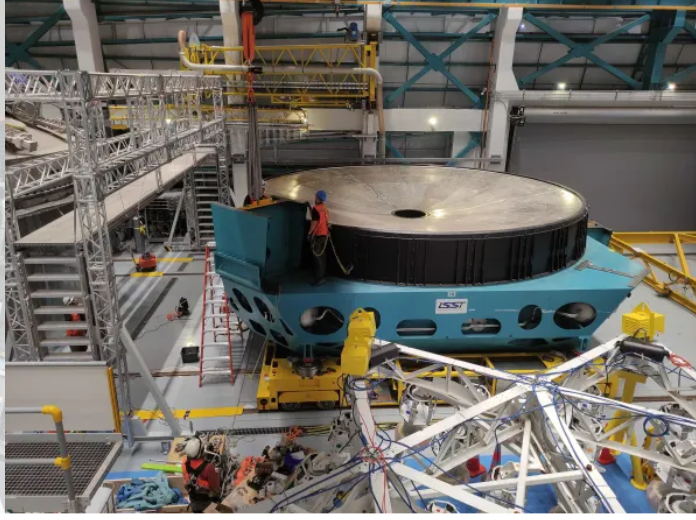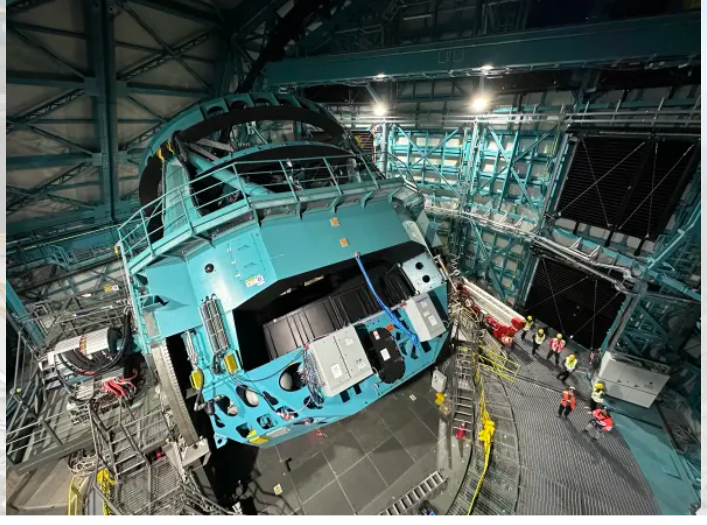The camera has the resolution of 300 mobile phones and each image will cover an area of the sky as large as 40 full moons – Aiming to discover unknown galaxies
The world’s largest digital camera is about to be activated which has been installed on a mountaintop in northern Chile.
Its mission is simple but ambitious: to photograph the entire night sky in exquisite detail and unlock some of the universe’s deepest secrets.
CCN’s extensive report reveals all the details of the new telescope.
Housed inside the Vera C. Rubin Observatory — a new telescope nearing completion on Cerro Pachón, a 2,682-meter (8,800-foot) mountain about 300 miles (482 kilometers) north of the Chilean capital Santiago.
Every three nights, the telescope will image the entire visible sky, producing thousands of images that will allow astronomers to see anything moving or changing brightness.
The expectation is that in doing so, Vera Rubin will discover about 17 billion stars and 20 billion galaxies that we’ve never seen before—and that’s just the beginning.
“There is so much that Rubin will do,” says Claire Higgs, the observatory’s astronomy specialist. “We’re exploring the sky in a way we’ve never done before, enabling us to answer questions we didn’t even think to ask.”
The telescope will survey the night sky for exactly a decade, taking 1,000 pictures every night. “In 10 years, we’ll be talking about new fields of science, new classes of objects, new types of discoveries that I can’t even tell you about now, because I don’t know what they are yet. And I think that’s a really exciting thing,” adds Higgs.
Preparing for activation
Under construction since 2015, the telescope is named after pioneering American astronomer Vera Rubin, who died in 2016 and, among other achievements, first confirmed the existence of dark matter – the elusive substance that makes up the majority of matter in the universe, but has never been observed.
The project was started in the early 2000s by private donations, including billionaires Charles Simonyi and Bill Gates. It was later jointly funded by the Department of Energy’s Office of Science and the US National Science Foundation, which also manages it together with the SLAC National Accelerator Laboratory, a research center operated by Stanford University in California.
Although Rubin is a US national observatory, it is located in the Chilean Andes, a location it shares with many other telescopes for several reasons. “For optical telescopes, you need a site high, dark and dry,” says Higgs, referring to the issues of light pollution and air humidity, which reduce the sensitivity of instruments. “You want a very quiet and understandable atmosphere, and the quality of the night sky in Chile is excellent, which is why there are so many telescopes here,” he adds. “It’s remote, but it’s also not so remote that getting the data off the mountain is a problem—there’s infrastructure that Rubin can lean on.”
10 million notifications per night
Rubin’s primary mission is called LSST — for Legacy Survey of Space and Time. “This is a 10-year survey in which we look at the southern sky every night and repeat every three nights. So we’re essentially creating a movie of the southern sky over a decade,” says Higgs.
The camera can take a photo every 30 seconds, which will generate 20 terabytes of data every 24 hours, as long as the average person watches Netflix for three years or listens to Spotify for 50 years. Upon completion, the survey will have generated over 60 million gigabytes of raw data.
However, it will only take 60 seconds to transfer each image from Chile to California, where AI and algorithms will first analyze it, looking for any changes or moving objects and generating an alert if anything is found.
“We expect about 10 million alerts per night coming out of the telescope,” says Higgs. “Alerts are anything that changes in the sky and cover a whole range of scientific events, including solar system objects, asteroids and supernovae. We expect millions of solar system stars and billions of galaxies, so machine learning is really essential.”
The data will be shared with a select group of astronomers each year, and then, after two more years, each data set will be made publicly available for the global scientific community to work with, Higgs says.
There are four main areas of research that we hope the data will cover: creating a catalog of the solar system — which includes the discovery of several new celestial bodies and perhaps the hidden planet known as Planet Nine; mapping our entire galaxy. exploring a special class of objects called ‘transients’, which change position or brightness over time. and understanding the nature of dark matter.
“There are probably 10 different areas of science where I can tell you that Rubin is going to do great,” Higgs says. “I think we’ll have more Type I supernovae in a few months than have ever been observed, for example. Interstellar objects, we have two candidates now, but Rubin will take it from two to hopefully more than a few.
“There are so many areas where we’re going to go from one or two things to a statistically large sample of something, and the scientific impact of what it can do is huge.”
“Revolutions are underway”
The astronomical community is very excited about the Vera Rubin Observatory, says David Kaiser, professor of physics and the Germeshausen Professor of the History of Science at the Massachusetts Institute of Technology. According to Kaiser, the telescope should help clarify long-standing questions about dark matter and dark energy — two of the most persistent and mysterious features of our universe.
“The Vera Rubin Observatory will allow astronomers to map the distribution of dark matter like never before, based on how dark matter bends the path of ordinary starlight — a process known as ‘gravitational lensing,'” Kaiser explains. “Dark matter appears to be ubiquitous throughout the universe, but exactly how it accumulated or aggregated over time remains difficult to quantify for large swathes of the night sky,” he says, adding that by gathering more data on its distribution of dark matter, the Vera Rubin Observatory could help astrophysicists discern its properties.
Another long-standing cosmic puzzle that Rubin could solve is his hunt Planet Nine. Konstantin Batygin, a professor of planetary science at the California Institute of Technology who has written several academic papers on the subject, says the telescope not only “provides a real opportunity for direct detection of Planet Nine, but even if the planet escapes from direct observation. “Detailed mapping of the dynamical architecture of the outer solar system—particularly the orbital distribution of small bodies—will provide critical tests for the Planet Nine hypothesis.” In short, he adds, the Vera Rubin Observatory is set to revolutionize our understanding of the outer solar system and is poised to be a “game changer.”
There are few astronomers who aren’t excited about Rubin, says Kate Pattle, a lecturer in the Department of Physics and Astronomy at University College London, because it will map space at scales ranging from the most local — tracking near-Earth asteroids. our own solar system — at its largest, mapping the distribution of dark matter throughout the universe.
“Rubin will return to the same parts of the sky again and again, which means it will break new ground in the study of astronomical transients – spotting variable stars, watching supernova remnants as they decay, and observing very high-energy gamma-ray bursts and the variability of quasars, which are very distant, very active galaxies. In doing so, it will provide unprecedented insight into how our universe and the stars and galaxies within it are evolving.”
According to Priyamvada Natarajan, a professor of astronomy and physics at Yale University, the Rubin Observatory is set to break records on many fronts, and the entire astronomical community is waiting for the first flight. The research will provide data for a myriad of scientific projects that will address many fundamental open questions in one go — from the near to the far universe, including not just a treasure trove of galaxies, clusters, quasars, supernovae, gamma-ray bursts and other transients — ” It will also sharpen our view of the solar system with a still-unparalleled inventory of near-Earth asteroids, Kuiper belt objects (a region of icy objects beyond the orbit of Neptune) — in short there is something for everyone,” he says.
He adds that the most exciting finding would be if the telescope revealed the true nature of dark matter—a discovery that would surely delight Vera Rubin.
“Ultimately, it was her seminal work on the detection of dark matter in spiral galaxies in the 1970s that drove this pursuit,” says Natarajan. “The prospects are tantalizing – and the revolutions are definitely underway”
Source :Skai
I am Terrance Carlson, author at News Bulletin 247. I mostly cover technology news and I have been working in this field for a long time. I have a lot of experience and I am highly knowledgeable in this area. I am a very reliable source of information and I always make sure to provide accurate news to my readers.














